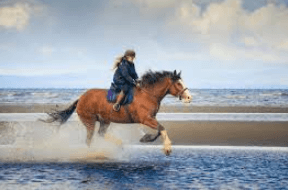
Introduction:
Horse riding, a sport steeped in tradition and excitement, combines the grace of equestrian skill with the thrill of competition. Within this dynamic arena, horse riding commentary stands as a pivotal element, transforming spectators’ experiences by providing insightful narrations that are as fluid as the riders’ movements. This comprehensive guide delves into the nuances of horse riding commentary, exploring its importance, techniques, and impact on the equestrian community.
Understanding Horse Riding Commentary:
Horse riding commentary is an auditory guide for audiences watching equestrian events, whether live or through a broadcast. It involves a commentator or a team of commentators who describe the unfolding action, offer expert analysis, and share background information on the competitors and horses. This verbal accompaniment is not just about narrating what is visible; it’s about enriching the viewers’ understanding of the sport.
Read horse riding commentary at https://abdellatifturf.com/.
The Role of Commentary in Equestrian Sports:
- Education: Commentators provide explanations of complex rules and judging criteria, which can be particularly enlightening for newcomers to the sport.
- Engagement: A commentator’s enthusiasm and knowledge can significantly enhance the viewing experience, keeping the audience invested in the competition.
- Storytelling: Through commentary, the stories of riders, horses, and their journey to the competition come to life, adding a layer of depth to the event.
Essential Skills for an Equestrian Commentator:
- Knowledge of the Sport: A deep understanding of horse riding, its various disciplines, and the subtleties of equine behavior and rider technique is crucial.
- Observation: Quick and accurate observation is key to providing timely and relevant commentary.
- Articulation: Clear and expressive communication helps convey the excitement and intricacies of the event.
- Adaptability: Events can be unpredictable, and commentators must adapt their narrative to reflect the changing dynamics.
Click https://toptierce.com/ for horse riding commentary.
Crafting Commentary for Different Equestrian Disciplines:
Each equestrian discipline has its unique set of challenges and highlights that a commentator must be adept at conveying:
- Dressage: Here, the focus is on precision, grace, and the harmony between horse and rider. Commentary should reflect the elegance and technical expertise on display.
- Show Jumping: This discipline is all about speed, agility, and the flawless execution of jumps. Commentary should mirror the intensity and fast pace of the event.
- Eventing: Combining dressage, cross-country, and show jumping, eventing requires commentators to be versatile and knowledgeable across multiple facets of horse riding.
The Impact of Technology on Horse Riding Commentary:
Advancements in technology have significantly influenced the way horse riding commentary is delivered and consumed. Live streaming, social media, and interactive platforms have opened new avenues for commentators to engage with a global audience. With instant replays and data analytics, commentators can provide more in-depth and accurate analysis, enhancing the viewing experience.
Read horse riding commentary at https://zecommentaires.net/.
Conclusion:
Horse riding commentary is an art form that requires a blend of expertise, quick thinking, and a passion for the sport. It plays an indispensable role in how equestrian events are enjoyed around the world. Aspiring commentators must cultivate a broad array of skills to excel in this field. Meanwhile, audiences can appreciate the rich narratives and keen insights that commentary brings to horse riding, deepening their appreciation for this captivating sport.
With its ability to inform, engage, and enthrall, horse riding commentary is more than just a voice over the action — it is the heartbeat of the equestrian spectator experience, making every canter, jump, and dressage move a story worth telling.